- Visibility 102 Views
- Downloads 9 Downloads
- DOI 10.18231/j.ijced.2020.018
-
CrossMark
- Citation
Clinico epidemiological study of vitiligo in children
- Author Details:
-
Syed Yousuf Ali *
-
Shaik Hazi Masthan Basha
Introduction
Vitiligo is a common acquired pigmentary disorder characterized by well-defined hypopigmented or depigmented macules due to absence or decrease in melanocytes. It is a common disorder affecting about 4% of the general population. Many studies have reported that around 50% of the patients have an onset before the age of 18 years and 25% before the age of 8 years.[1], [2] It causes emotional trauma in children.[3]
Vitiligo may present anytime in life, including the neonatal period and childhood. Childhood vitiligo contributes to about 25% of total vitiligo cases.[4] The average age in different studies ranges from 4 to 8 years with a very early start possible from the age of 3 months .[5], [6]
The existence of congenital forms is controversial.[7] In people with fair skin, vitiligo is usually visible after a first exposure of sun that will accentuate the contrast with healthy skin.[6], [8], [9] In general, childhood vitiligo differs from the adult vitiligo in the following aspects: a female preponderance is observed, segmental presentation is more commonly seen and associated autoimmune disorders are rare.[10]
The aim of this study is to know the clinico epidemiological pattern of vitiligo in children. And to study the epidemiological aspects and clinical profile of children with vitiligo.
Materials and Methods
The study was conducted in the Department of DVL, Shadan Institute of Medical Sciences. It is a tertiary care centre in Hyderabad. It was a Cross sectional study conducted during October 2017 To August 2019.
A total of 50 children of age between 3-14 years with vitiligo and who have given informed written consent are included in study. And patients who are not willing to give written consent and participate in the study were excluded.
Procedure
Ethical clearance was obtained from the Institutional Ethical Committee, Shadan Institute of Medical Sciences, Hyderabad. A designed, coded proforma was used for recording the findings. The duration of the interview was up to 30 minutes for each individual.
Epidemiological information like age, gender, education, occupation, residence etc were taken and recorded.
Chief complaints related to skin, itching, skin lesions, past history of similar lesions or family history, any exacerbating factors, any associated medical or skin diseases etc. was recorded for clinical data.
Vitiligo was assessed according to VIDA scoring system. [11] The VIDA is a six-point scale for assessing vitiligo activity. It is based on the patient’s own opinion of the disease activity. A low VIDA score indicates less activity. Active vitiligo involves either expansion of existing lesions or appearance of new lesions. Grading is as follows:
+4 : Activity of 6 weeks or less duration; 3 : Activity of 6 weeks to 3 months; +2 : Activity of 3 - 6 months; +1 : Activity of 6 - 12 months; 00 : Stable for 1 year or more; and -1 : Stable with spontaneous re-pigmentation since 1 year or more.
The data was entered in Microsoft Excel 2010 version. Data was analysed using Microsoft Excel 2010 and Epi Info 7.2.0. Descriptive and inferential statistical analysis were used in the present study. Results on continuous measurements were presented on Mean ± SD (Min-Max) and results on categorical measurements were presented in Number (%). Significance was assessed at 5% level of significance.
Results
Epidemiological Profile
Most of the study population belonged to the age group of 9-11 years, the mean age of onset was 9 years. Most of them are females, Majority are Hindus. Among them majority were studying 1st– 5th standard [Primary school]. Most of them are resided in urban areas. And many of them belongs to middle class as per socio economic status.
Clinical profile
The most common vitiligo was vitiligo vulgaris in 46% of cases {fig 1}, followed by focal in 36%, mucosal in 8% {fig 2} and acrofacial in 6%. Only 4% of them has segmental vitiligo.
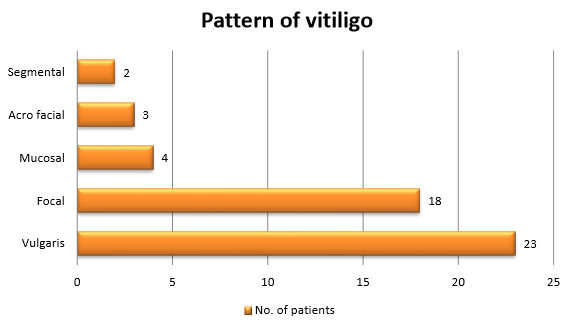
The most common site of involvement was lower limbs in 42% of cases, followed by face in 26%, Upper limb in 14%, scalp in 6% of cases. Mucosal involvement was seen in 12% of cases. Oral mucosa was involved in 8% and genital involvement was seen in 4% of study population.
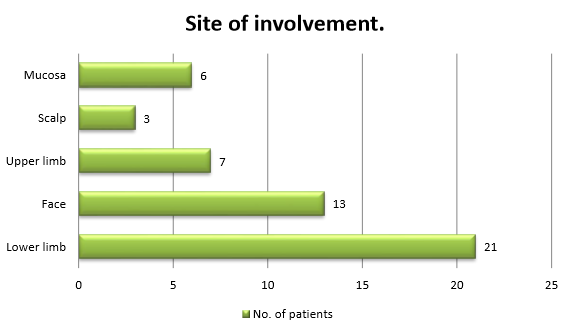
The most common associated feature was leukotrichia in 24% of cases, followed by Koebner’s Phenomena in 18%, Atopic dermatitis in 14%, Halo nevi in 4% and alopecia areata in 2% of study population.
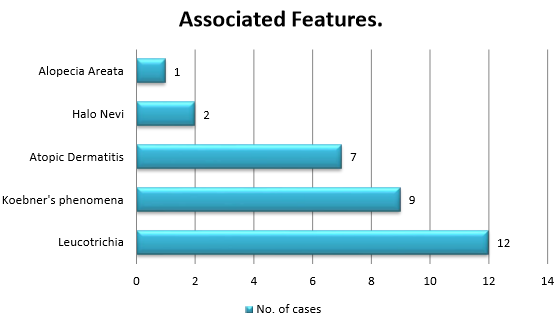
The most common associated condition was photosensitivity seen in about 10% of cases, Refractive errors seen in 8%, clinical hypothyroidism was present in 4% and hearing abnormalities in 2% of cases. family history was positive in only 4% of the cases. The mean age of onset was 6 years which is lesser when compared to general population. Most of them were in the active stage of disease [86%]. Only 14% of them had VIDA score of 0 to -1.
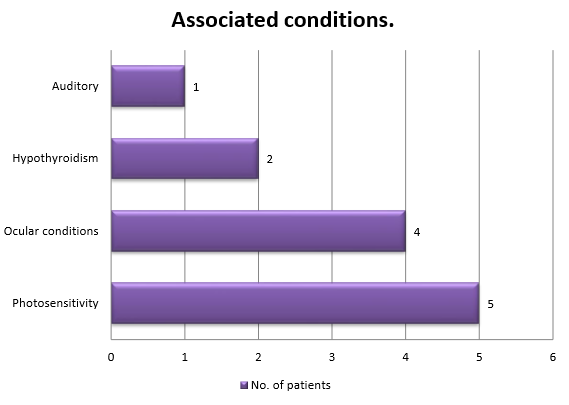
Discussion
Epidemiological Profile
In our study, most of the children belonged to age group of 9-11 years, the mean age of onset was nine years. Majority are females in the study population. Most of them were Hindus, lived in urban localities, belonging to middle class of socioeconomic status, the findings of our study are in concurrence with many other studies[12], [13]
A study done by Kambil [14] with 40 children under 14 years of age with vitiligo in Kerala 18 were boys (45%) and 22 were girls (55%),[15] A study done by Preeti Keyur Sheth, S Sacchidanand, GS Asha [3] in the Bangalore Medical College reported that among 100 patients, we had 55 female patients and 45 male patients, in 9 months duration of the study. The findings of the above studies are in concurrence with the findings in the studies done by many others.[16], [17], [13], [18] In contrast to all above studies, out of the 90 children with vitiligo in a study by Jaisankar et al [19], 39% were boys and 61% were girls, which was statistically significant.
Clinical Profile
Pattern of Vitiligo
In our study, the most common vitiligo was vitiligo vulgaris in 46% of cases {[Figure 5] }, followed by focal in 36%, mucosal in 8% {[Figure 6] } and acrofacial in 6%. Only 4% of them has segmental vitiligo.
In the study done by Preeti Sheth, Sacchidanand, Asha [3], stated that the most common pattern of vitiligo was vulgaris - 46%, followed by focal - 36%, mucosal - 8%, acro‑facial - 7%, segmental - 3% of study population. Vitiligo may present in childhood in various morphological patterns. The most common pattern seen in many studies is vitiligo vulgaris, followed by focal and segmental vitiligo [20], [21] whereas acro‑facial and mucosal vitiligo have a lower incidence.[22], [5], [8], [19], [14]
Site of Involvement
In our study, the most common site of involvement was lower limbs about 42% of cases, followed by face in 26%, Upper limb in 14%, scalp in 6% of cases. Mucosal involvement was seen in 12% of study population. Oral mucosa was involved in 8% and genital area involved in 4% of the cases of mucosal involvement. A study done by Neerja Puri [13] reported that the most common site of involvement was face 30%, neck 30% and legs 30%, followed by trunk, arms and mucosal in 10% of cases each.16,3,8,24,27.
Associated Features
In our study, the most common associated feature was leukotrichia in 24% of cases. Koebner’s phenomenon is another common feature seen in vitiligo, which is an indicator of disease activity, in our study it is seen in 18% of cases, followed by Atopic dermatitis in 14%, Halo nevi in 4% and alopecia areata in 2% of cases.In the study done by Preeti Sheth, Sacchidanand, Asha [3], leukotrichia was seen in 25% of patients, whereas Koebner’s phenomenon was seen in 21% of patients. Similar findings were seen in study done by Puri[23] were Koebner’s phenomenon positive in 20% of cases. In the study done by Kambil [14] Leukotrichia was seen in 25% of cases. A study done by Gurrala Satyanarayan Reddy, N. Arun [12] stated that Leukotrichia was present in 27% and Koebner’s phenomenon in 24% of cases. Beliappa et al [24] and Kayal et al [25] have reported Koebner’s in 26% and 36% of cases respectively.
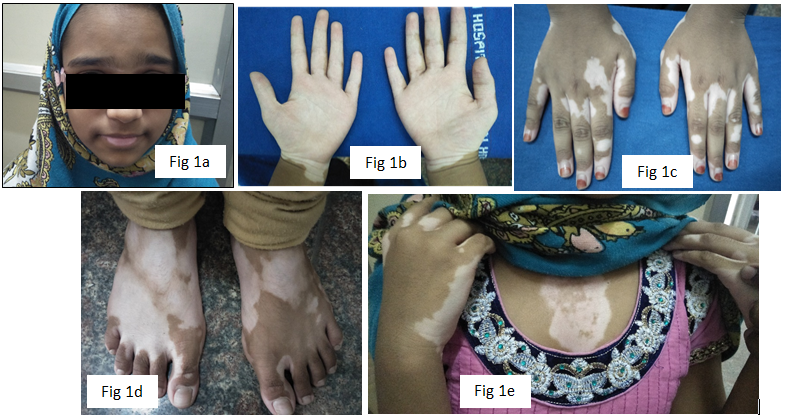

Associated Conditions
In our study, the most common associated condition was photosensitivity about 10% of study population. Refractive errors seen in 8% of cases, hypothyroidism was present in 4% and hearing abnormalities was present in 2% of cases. A study done by Neerja Puri [13] reported that hypothyroidism was seen in 50% of cases, autoimmune thyroiditis in 10%, alopecia areata in 10%, and atopic dermatitis in 10% of cases, psoriasis in 3%, and premature greying of hairs in 3.3% were seen in study group. A study done by Preeti Sheth, Sacchidanand, Asha [3] reported that the most common association with vitiligo in children was atopic dermatitis in 13% of cases, while hypothyroidism was seen in 1 case, halo nevi were seen in 3 cases and alopecia areata in 1 case. All these autoimmune disorders were found exclusively in children with non-segmental vitiligo. In contrast to the above studies, Jaisankar et al. [19] did not show any association of autoimmune condition with vitiligo.
In our study, family history was seen only in 4% of cases. The mean age of onset was six years which is lesser when compared to general population. A study done by Preeti Sheth, Sacchidanand, Asha [3], reported that familial association like thyroid diseases and atopic dermatitis were noted in 7 patients each (about 7%). Children with familial association had a mean age of onset of 6.8 years, which was earlier than age of onset of children with no familial association of 9.2 years. A study done by Kambil [14], reported that the family history was seen in 15% of study population. Manali et al [17] and Rangaraj [18] have noted that family history positive in 17% and 12% of cases respectively.
In our study, 86% of them were in the active stage of disease {VIDA score of +1 to +4}. Only 14% of them had VIDA score of 0 to -1. A study done by Preeti Sheth, Sacchidanand, Asha [3], recorded that score of +4 seen in 81 cases, followed by +3 seen in 6 cases, +1 in 2 cases and +2 in 2 cases, 0 in 4 cases and −1 in 5 cases of study population.
Conclusion
The female predominance is high in prevalence of vitiligo in children and an earlier age of onset seen among children with family history of vitiligo or autoimmune disorders. Vitiligo vulgaris is the most common presentation, and lower limbs being the most common site of involvement in children.
Source of funding
None.
Conflict of interest
None.
References
- Paolo Iacovelli, Jolinda L.M. Sinagra, Andrea Paro Vidolin, Samantha Marenda, Bruno Capitanio, Giovanni Leone. Relevance of Thyroiditis and of Other Autoimmune Diseases in Children with Vitiligo. Dermatol 2005. [Google Scholar]
- SureshKumar Jain, Sarita Kalwaniya, Ramesh Kumar, Prafull Mehta, Naresh Banjara, Manali Jain. Clinical profile of childhood vitiligo patients in Hadoti region in Rajasthan. Indian J Paediatr Dermatol 2014. [Google Scholar]
- PreetiKeyur Sheth, S Sacchidanand, GS Asha. Clinico-epidemiological profile of childhood vitiligo. Indian J Paediatr Dermatol 2015. [Google Scholar]
- ArunC Inamadar, Aparna Palit. Childhood vitiligo. Indian J Dermatol, Venereol, Leprol 2012. [Google Scholar]
- Soyun Cho, Hyung-Chul Kang, Jeong-Hee Hahm. Characteristics of Vitiligo in Korean Children. Pediatr Dermatol 2000. [Google Scholar]
- S Prcic, V Duran, M Poljacki. Vitiligo in childhood. Med Pregl 2002. [Google Scholar]
- J J Nordlund, A B Lerner. It is important. Arch Dermatol 1982. [Google Scholar]
- Sanjeev Handa, Sunil Dogra. Epidemiology of Childhood Vitiligo: A Study of 625 Patients from North India. Pediatr Dermatol 2003. [Google Scholar]
- Juliette Mazereeuw-Hautier, Sophie Bezio, Emmanuel Mahe, Christine Bodemer, Catherine Eschard, Valérie Viseux. Segmental and nonsegmental childhood vitiligo has distinct clinical characteristics: A prospective observational study. J Am Acad Dermatol 2010. [Google Scholar]
- Sanjeev Handa, Inderjeet Kaur. Vitiligo: Clinical Findings in 1436 Patients. J Dermatol 1999. [Google Scholar]
- Urmila Bhor, Sushil Pande. Scoring systems in dermatology. Indian J Dermatol, Venereol Leprol 2006. [Google Scholar]
- Gurrala Satyanarayan Reddy, N. Arun. Clinicoepidemiological Study of Childhood Vitiligo. Int J Contemporary Med Res [IJCMR] 2019. [Google Scholar]
- N Puri. A clinico-epidemiological study on childhood vitiligo. Indian J Paediatr Dermatol 2016. [Google Scholar]
- Srirath Madappally Kambil. Clinical profile of childhood vitiligo at a tertiary hospital in North Kerala. Int J Res Dermatol 2018. [Google Scholar]
- M Gupta. Childhood vitiligo: A clinicoepidemiological study. Indian J Paediatr Dermatol 2018. [Google Scholar]
- Stephen O. Kovacs. Vitiligo. J Am Acad Dermatol 1998. [Google Scholar]
- SureshKumar Jain, Sarita Kalwaniya, Ramesh Kumar, Prafull Mehta, Naresh Banjara, Manali Jain. Clinical profile of childhood vitiligo patients in Hadoti region in Rajasthan. Indian J Paediatr Dermatol 2014. [Google Scholar]
- Rangaraj Murugaiyan. Epidemiological study, clinical spectrum and associations of childhood vitiligo in a tertiary care centre. Int J Res Dermatol 2016. [Google Scholar]
- T JJaisankar, M C Baruah, B R Garg. VITILIGO IN CHILDREN. Int J Dermatol 1992. [Google Scholar]
- Z Hu, J B Liu, S S Ma, S Yang, X J Zhang. Profile of childhood vitiligo in China: analysis of 541 patients. Pediatric Dermatol 2006. [Google Scholar]
- SONJA PRCIC, VERICA DJURAN, ALEKSANDRA MIKOV, IVAN MIKOV. Vitiligo In Children. Pediatric Dermatology 2007. [Google Scholar] [Crossref]
- Saurabh Agarwal, Shalini Gupta, Amit Ojha, Rajesh Sinha. Childhood Vitiligo: Clinicoepidemiologic Profile of 268 Children from the Kumaun Region of Uttarakhand, India. Pediatric Dermatol 2013. [Google Scholar]
- N Puri. A clinico-epidemiological study on childhood vitiligo. Indian J Paediatr Dermatol 2016. [Google Scholar]
- BelliappaPemmanda Raju, Umashankar Nagaraju. Profile of childhood vitiligo with associated ocular abnormalities in South India. Indian J Paediatric Dermatol 2016. [Google Scholar]
- AshokK Khare, Sharad Mehta, Asit Mittal, CM Kuldeep, Ashu Kayal, LalitK Gupta. Pattern of childhood onset vitiligo at a tertiary care centre in south- west Rajasthan. Indian Journal of Dermatology 2015. [Google Scholar] [Crossref]
